Lane Community College: The Parnell Years
Part Two: The Parnell Presidency, 1965-1968
- Section A
- Section B
- Section C
- Section D
The Enormous Challenge
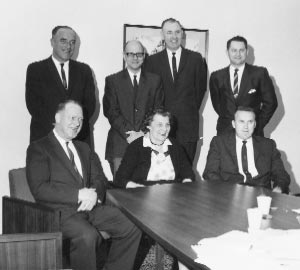
Charter Board of Directors, 1964 Left to right,
standing: Ken Schmidt, Bill Bristow, Cliff
Matson, Al Brauer; sitting: Lyle Swetland,
Olga Freeman, Dean Webb
The enormity of creating a new college didn't seem to faze board members. They saw the challenge as a rare opportunity; to be approached with enthusiasm and energy. The newly elected Board of Directors held its first official meeting on November 4, 1964. The board quickly got to work, meeting twice monthly.
The board appointed Bert Dotson as district clerk and instructed him to get a presidential search underway. They elected a chairman and vice chairman and appointed subcommittees to acquire land for a campus, negotiate for absorption of Eugene Technical-Vocational School into the college, develop the curriculum, and choose a name for the college.
Finding a College Name
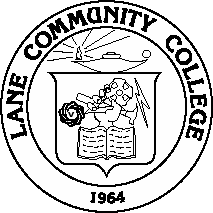
LCC seal designed
by student David
Spriggs, 1964
Among the suggestions for a college name were Emerald Valley, Rivers View, Green Mountain, Upper Willamette, and Joseph Lane (the first governor of Oregon Territory). Lane Community College was chosen, naming the college after the county.
ETVS students were invited to suggest a design for a college seal. The seal was designed in1964 by David L. Spriggs, future student body president, and was adopted by the board on March 17, 1965. He started with a hand "because workers use their hands; added a 30-degree triangle to represent drafting engineering, mathematics, science and surveying; a gear wheel to represent machinists, mechanics and others; a hammer to represent carpentry and cabinet makers; a symbol for the atom to represent electronics and science; a spark for radio; the book of knowledge for college-transfer students; and a lamp of knowledge for nursing."

An early version of
the Lane Titan
mascot, 1965
ETVS students requested that their school colors, blue and white, be adopted for the new college. In the first student body election in fall 1965, Titan, a Greek mythological figure, was chosen as the school mascot. The student newspaper was named The Torch at the same election.
Choosing a President
Some 20 applicants responded to the board's national search for a college president. Five were interviewed including Dale Paul Parnell, Intermediate Education District Superintendent in Eugene.
There was strong support for a homegrown man to lead the new college. "I know that Parnell excited me in a lot of my thinking," board member Albert Brauer remembers. "He really had a vision that made sense. Nearly all the school districts gave him support.... He knew the area, he was an Oregonian, and that's special."
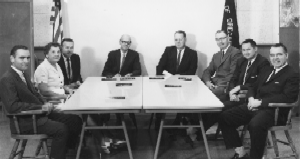
Second Board of Directors, 1965 From left, Robert Ackerman, Olga Freeman, Dean Webb, William Bristow, Lyle Swetland, Clifford Matson, Albert Brauer, Dale Parnell
At a special meeting on February 24, 1964, the board selected Parnell as the first college president.
Hiring a Staff
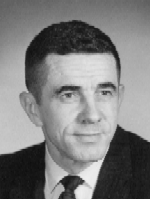
Bert Dotson, Assistant to
the President, 1965-1982
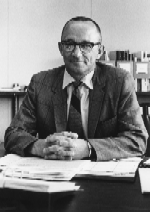
I.S. "Bud" Hakanson,
Dean of Student Services,
1965-1969
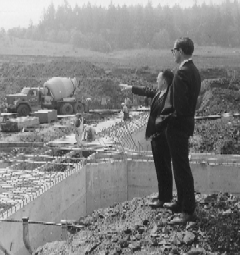
Dale Parnell (left) with
William Hein, Dean of Instruction
(1965-1968) viewing construction
of new campus, 1966-1967
Dale Parnell was the first person the board paid to work for Lane; Bert Dotson was the first person the board hired, first in February 1964 as college planner and in October 1964 as clerk.
The first staff was built around ETVS, which brought 41 people to the new college. A total of 157 employees were hired that first year; the total number of staff grew to 247 in the second year.
National searches to fill both administrative and faculty positions were routine from the beginning. Oregonians from high schools, community colleges and a few universities were well represented among the early employees, but the mix included people from around the nation.
Prior to fall term 1965 salary schedules were created for classified staff, faculty and managers. A staff handbook was prepared, and plans were made for formal staff input into administrative decision making.
Openness and emphasis on communication characterized the Parnell years at Lane. He formed a division council in 1965 to act as a sounding board between departments and their staffs and the administration.
In December 1965 employees elected the first Staff Personnel Policies Committee. Parnell, in effect had an in-house union. However, the cohesiveness found in the college in the early years began to dissolve as the staff grew larger in numbers, its needs and requests expanded in the face of tighter funding, and it found the board and administration less able to be accommodating. Collective bargaining was a few years away.
Curricula and Accreditation
The plan called for the new college to organize around the existing Eugene Technical-Vocational School. The board made it official at its first two meetings, voting to retain ETVS administrative, teaching, clerical, and custodial staff.
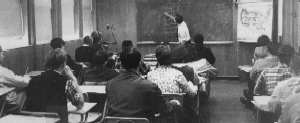
History Class
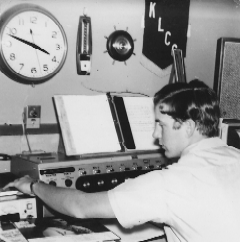
Radio communications, KLCC radio
Lane immediately had technical- vocational programs, courses in liberal arts and pre-professional fields, evening adult programs, and Manpower Development Training Act (MDTA) programs. The fall term 1965 schedule of classes listed 295 credit class sections and 32 non-credit adult class sections, offered in 14 locations throughout the district. In the next few years, enrollment surpassed expectations and county school districts asked the college to take over high school completion and adult evening programs.
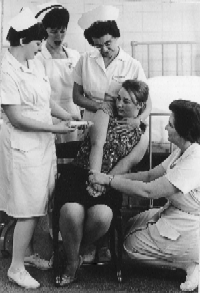
Nursing Students
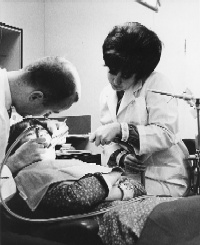
Dental Hygiene
Accreditation of the college went smoothly. In December 1966 Lane's membership in the Commission on Higher Schools of the Northwest Association of Secondary and Higher Schools was accepted. Following a self-study and visit by an Association committee, Lane was given full accreditation in December 8, 1968.
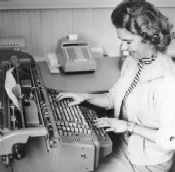
Manpower Development
Training Act (business) student
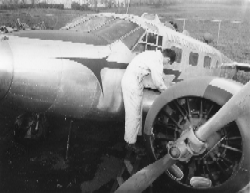
Aviation Mechanics
Students by the Thousands
When the doors opened for the college in the fall of 1965, there were 1,622.4 full-time equivalent students (FTE) and a headcount of 7,694 students.
The first students to register at Lane were 23 practical nursing students who enrolled on July 5, 1965. All but one graduated a year later.
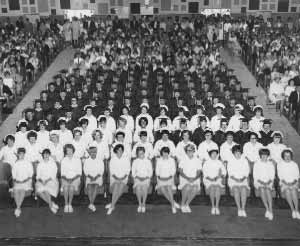
First graduating class, nursing students in front rows, 1966
A profile of credit students in spring term 1966 indicated that 74 percent were male and 58 percent in the 18- to 20-year-old category. College transfer courses attracted 67 percent; the rest were in occupational programs. About 16 percent were veterans; about 52 percent worked while attending school.
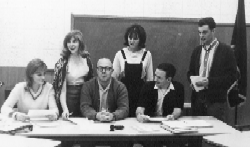
Student Council officers, from left: Pam Shurtliff, Kathy Downing, Charles Solomon (president), Gigi Gamble, Dennis Ryan, Darrol Gesh, 1965-1966
From the first, Presdient Parnell had the student body president sit at the board of education table during meetings, with a right to speak though not to vote. Students were invited to serve on college committees, and the president's door was always open to them.
Temporary Facilities
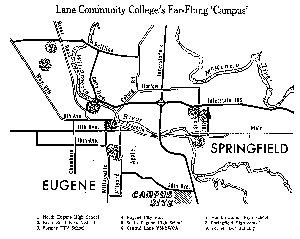
LCC facilities in Springfield.
Courtesy of Eugene Register-Guard
Large image of Springfield building
Through the courtesy of Eugene School District 4J, the college was able to lease for three years the ETVS facilities at 200 N. Monroe Street (currently housing the district offices for the Eugene 4J School District) . That took care of most tech-voc instructional needs until a campus could be built and provided a headquarters for the college and a suite of administrative offices.
Additional classrooms and offices to accommodate the teaching of college transfer courses were provided through a three-year lease of the vacant Georgia-Pacific Corporation building in Springfield. In the second year, the college added more classrooms by leasing the vacant Bethel Elementary School in Eugene.
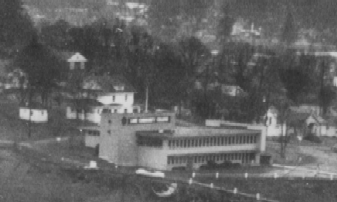
Lane Community College facilities in Springfield. Courtesy of Eugene Register-Guard
Students and staff accepted the limitations of the temporary facilities in good humor. Stories about parking tickets at the Springfield campus and miniature-scale bathroom plumbing and hallway drinking fountains at Bethel became the stuff of legend as the years passed.
During the three years before the college occupied its main campus, it rented or leased nearly four dozen locations in which to hold classes.
Building a Campus
Within a few weeks of inviting the public to suggest or offer possible sites for the new college, the board subcommittee on land acquisition had four offers. A fifth possibility emerged early in 1965. Eugene lumberman-industrialist Wilfred Gonyea offered Lane 100 free acres of his property located on the south side of Eugene's 30th Avenue along the west side of Interstate 5. The location had access to primary roads, was geographically central, and the price was right. The college accepted Gonyea's offer on March 17, 1965, and purchased an additional 48.81 acres south and west of the donated land on August 16, 1967.
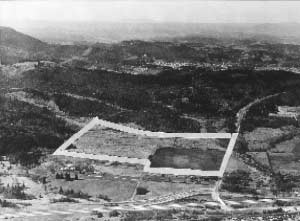
Aerial view of the LCC site on 30th Avenue, 1965 Large image of aerial view
The land that became Lane Community College was originally settled by William and Eleanor Moore who traveled by ox team from Ohio on the Oregon Trail. They filed donation land claims on 320 acres on the site in 1853. Facing an urgent need to have a campus ready by fall 1968, when leases expired on temporary facilities, the board got planning underway in fall 1965. The Eugene architectural firm of Balzhiser, Seder & Rhodes was hired in September to plan the campus. Trips were arranged to other college campuses to study campus design. Out of the trips came such ideas as mixing the tech-voc and college transfer buildings so that status was not assigned according to location or style of building, locating the Learning Resource Center and student center in the middle of the cluster of buildings because they serve all students, locating administration and business buildings close so they could share computer facilities, locating sports facilities close to the campus entrance and parking, and creating non-structural walls to allow easy remodeling as educational needs change. Board members rejected suggestions that the new campus be built a building at a time, as needed.
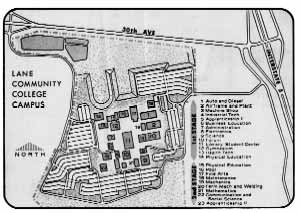
LCC campus on 30th Avenue, Eugene Eugene
Register-Guard, February 19, 1967
Members voted to build 11 structures in the first stage, then later increased that to 13. About 100 spectators watched the groundbreaking ceremony in chilly, overcast 40-degree weather on January 6, 1967. U.S. Senator Wayne Morse, officials representing state and local education, W.H. Gonyea, donor of part of the campus acreage, the great-great-granddaughter of William and Eleanor Moore who first settled the land in 1853, and others attended the groundbreaking. In the next eight months, the board members awarded contracts for construction of 13 buildings. Only the Forum and Center Buildings were not ready for occupancy when classes began on the new campus in September 1968.
By July 1968 the move to the new campus had begun. When students arrived in September, they had to contend with workers putting the finishing touches on most buildings, and later with sawdust paths through mud where sidewalks had yet to be poured. But, the mood was upbeat as they moved among the first 13 buildings costing $16.3 million.
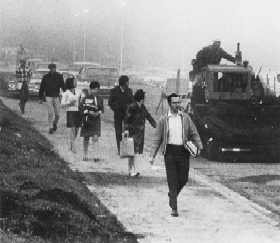
First day of classes on 30th Avenue campus,
September 1968, courtesy of The Register Guard
Financing the College
The election held on October 19, 1964, which established the college and elected the board did not, however, authorize any operating money. A small loan covered operating expenses during the first 6 months.
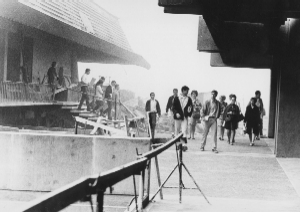
First day of classes on 30th Avenue campus,
September 1968 Courtesy of Eugene Register-Guard
A college budget committee was named within a month of the founding election. The board put two measures before voters on May 3, 1965: a $540,106 operating budget property tax levy and a five-year, $400,000 per year serial levy to help pay for constructing a new campus. Both measures were approved by the voters.
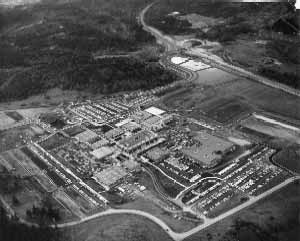
Aerial view of LCC 30th Avenue campus, November 1968.
Photograph courtesy of Skyview Aerial Surveys, Inc.
The end of a moratorium on state funding was lifted by the legislature and the college received about half a million dollars from the state toward operating costs in its first year. To finance the college's second year, 1966-1967, a property tax levy was passed by the voters in May 1966.
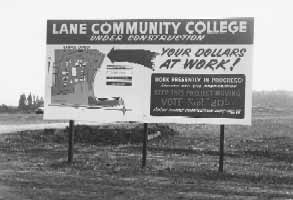
Billboard urging support of bond measure for Lane
Community College construction, 1966
Money was still needed to build the new campus. A $9.9 million construction bond issue was placed on the September 20, 1966 ballot and was passed by the voters. In addition, the college received state and federal grants for construction totaling $5.6 million by 1969.
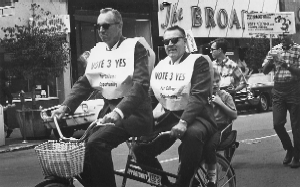
Eugene Mayor Edward Cone (left) and LCC President Dale Parnell (right) in parade to support bond measure to fund higher education, May 24, 1968
Seeking greater financial statiblity, the board on May 28, 1968 put a tax base request before voters. It's passage made possible a $3.4 million operating budget for 1968-1969.
The Parnell Precedent
Lane had experienced success after success in its early efforts. Things were going well as the end of the 1967-68 year approached. "We were really riding high with Parnell running the show, and the school was really moving," recalls board member Al Brauer. Community support was outstanding. Staff morale and commitment were never higher. The college was in excellent financial shape. A new campus was about ready for occupancy. Enrollment was growing. The college was achieving its mission.
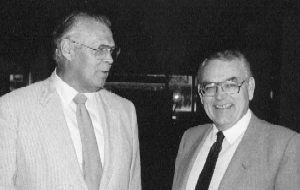
Eldon Schafer (left), president, 1970-1985,
Dale Parnell (right), president, 1965-1968
Then, in Salem, on May 10, 1968, Governor Tom McCall announced that he was appointing Dale Parnell as Oregon Superintendent of Public Instruction, effective July 1. Parnell resigned from Lane in November 1968. The board named Robert E. Hamill, Lane's director of Institutional Research as acting president for 1968-69, and began a national search for their second president. Robert L. Pickering served as president, 1969-1970. Looking back, board members, staff and community leaders knew they'd had unusually effective leadership for three years and a month. Few realized that his influence would live on through the college's early decades, and probably a lot longer. Parnell empowered and energized people by inviting them to become partners in building an institution to which they could give unreserved commitment. The Parnell version of shared governance or participative decision making was part accountability and part democracy. If he was rigid about getting the job done, he was equally flexible about giving people freedom to perform. He borrowed a slogan from a poster of the day, "To Do a Common Thing Uncommonly Well," and used it as a low-key rallying call.
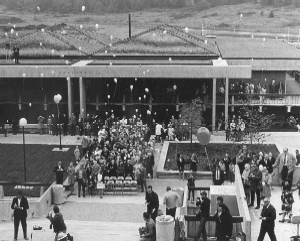
Dedication of 30th Avenue campus, October 11, 1969
Eldon G. Schafer was Lane's president, 1970-1985. Gerald Rasmussen, instructional administrator, says that Parnell and Schafer "are very much a part of the Western tradition of individualism and of opportunity. They're comfortabale in dealing with other poeple who are willing to express themselves and to disagree and debate. They're problem-oriented people and they deal with human beings at a very, very comfortable basis of equality."
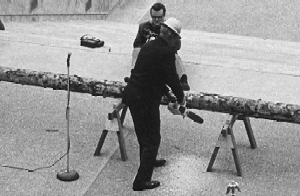
Governor Tom McCall used a chain saw to cut a log,
replacing the traditional ribbon-cutting ceremony
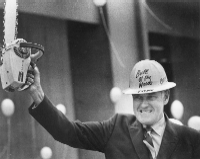
Governor Tom McCall with chain saw
The unparalleled productivity of the Parnell years would be remembered, but even that giant accomplishment would be seen as secondary to the establishment of participative governance. There was no retreat from the Parnell precedent.
Return to: Lane Community College: The Parnell Years / Welcome


